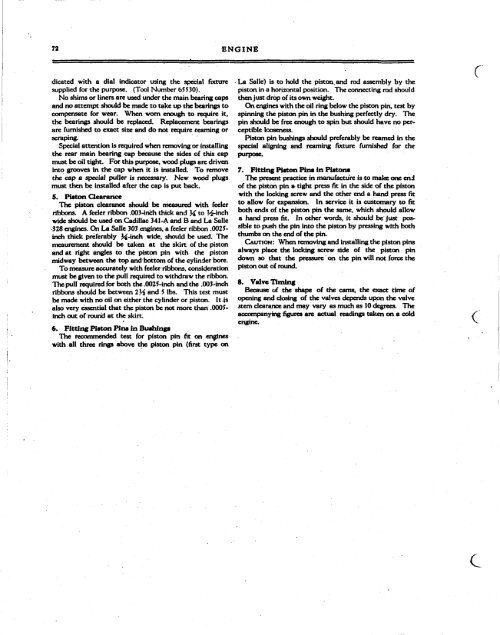1928 Cadillac - GM Heritage Center
1928 Cadillac - GM Heritage Center
1928 Cadillac - GM Heritage Center
Create successful ePaper yourself
Turn your PDF publications into a flip-book with our unique Google optimized e-Paper software.
72 ENGINE<br />
dicated with a dial indicator using the special fixture<br />
supplied for the purpose. (Tool Number 65530).<br />
No shims or liners are used under the main bearing caps<br />
and no attempt should be made to take up the bearings to<br />
compensate for wear. When worn enough to require it,<br />
the bearings should be replaced. Replacement bearings<br />
are furnished to exact size and do not require reaming or<br />
scraping.<br />
Special attention is required when removing or installing<br />
the rear main bearing cap because the sides of this cap<br />
must be oil tight. For this purpose, wood plugs are driven<br />
into grooves in the cap when it is installed. To remove<br />
the cap a special puller is necessary. New wood plugs<br />
must then be installed after the cap is put back.<br />
5. Piston Clearance<br />
The piston clearance should be measured with feeler<br />
ribbons. A feeler ribbon .003-inch thick and J£ to V£-inch<br />
wide should be used on <strong>Cadillac</strong> 341-A and B and La Salle<br />
328 engines. On La Salle 303 engines, a feeler ribbon .0025-<br />
inch thick preferably Ji-inch wide, should be used. The<br />
meaurement should be taken at the skirt of the piston<br />
and at right angles to the piston pin with the piston<br />
midway between the top and bottom of the cylinder bore.<br />
To measure accurately with feeler ribbons, consideration<br />
must be given to the pull required to withdraw the ribbon.<br />
The pull required for both the .0025-inch and the .003-inch<br />
ribbons should be between 2½ and 5 lbs. This test must<br />
be made with no oil on either the cylinder or piston. It-is<br />
also very essential that the piston be not more than .0005-<br />
inch out of round at the skirt.<br />
6. Fitting Piston Pins in Bushings<br />
The recommended test for piston pin fit on engines<br />
with all three rings above the piston pin (first type on<br />
La Salle) is to hold the piston, and rod assembly by the<br />
piston in a horizontal position. The connecting rod should<br />
then just drop of its own weight.<br />
On engines with the oil ring below the piston pin, test by<br />
spinning the piston pin in the bushing perfectly dry. The<br />
pin should be free enough to spin but should have no perceptible<br />
looseness.<br />
Piston pin bushings should preferably be reamed in the<br />
special aligning and reaming fixture furnished for the<br />
purpose.<br />
7. Fitting Piston Pins in Pistons<br />
The present practice in manufacture is to make one end<br />
of the piston pin a tight press fit in the side of the piston<br />
with the locking screw and the other end a hand press fit<br />
to allow for expansion. In service it is customary to fit<br />
both ends of the piston pin the same, which should allow<br />
a hand press fit. in other words, it should be just possible<br />
to push the pin into the piston by pressing with both<br />
thumbs on the end of the pin.<br />
CAUTION: When removing and installing the piston pins<br />
always place the locking screw side of the piston pin<br />
down so that the pressure on the pin will not force the<br />
piston out of round.<br />
8. Valve Timing<br />
Because of the shape of the cams, the exact time of<br />
opening and closing of the valves depends upon the valve<br />
stem clearance and may vary as much as 10 degrees. The<br />
accompanying figures are actual readings taken on a cold<br />
engine.
















